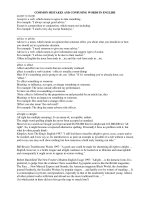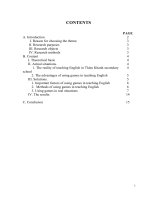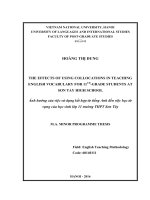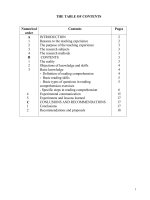COMMON MISTAKES OF SECODARY STUDENTS IN PRONUNCING ENGLISH CONSONANTS
Bạn đang xem bản rút gọn của tài liệu. Xem và tải ngay bản đầy đủ của tài liệu tại đây (121.82 KB, 20 trang )
Part A: Introduction
1. Rationale for choosing the topic
The English language has become the international language for
communication, and is used widely in many countries in the world. In
Vietnam, English is the most popular foreign language to be used as a
mean of communication. However, it is not easy for most of Vietnamese
people to pronounce more properly. Like some other language,
Vietnamese has phototoxic features that keep native learner from
pronouncing English like native speaker.
Like learners elsewhere in the world, Vietnamese learners encounter great
difficulties in learning English pronunciation for several reasons. Firstly,
the English sound system has several sounds foreign to Vietnamese
speakers. Secondly, the way English speakers pronounce the ending
sounds is completely different from the one deeply rooted in Vietnamese
speakers , making it more difficult for them to achieve appropriate English
pronunciation. The limitation of Vietnamese word-final sounds and the
frequency of English word-final consonants errors which are made by
most Vietnamese speakers as well as my secondary students have caught
significant attention to this area of the topic. That is the reason why I
choose
this
study:
“COMMON
MISTAKES
OF
SECODARY
STUDENTS IN PRONOUNCING ENGLISH CONSONANTS”
2.Aims and Objectives:
The aims of this research is to offer a systematic study of the
articulation of word final consonants of Vietnamese–accounted English in
pronouncing English of secondary students. More over this study will help
teachers and students in my school understand features and the usage of
English consonant more clearly to communicate more successfully. As a
result, they will avoid some common mistakes in pronunciation English.
3. Scope of research:
1
+ English consonants
+ the difference between Vietnamese final consonant and English final
consonants
4. Methodology;
In order to complete this study, both quantitative and qualitative methods
have been applied to collect the data. The instruments are questionnaires,
classroom observation, interviews and pronunciation exercises.
- Description:
The study was set up to answer the following question:
What are the most common pronunciation problems of the students in a
Secondary school?
Firstly, the system of English consonants, secondly the differences in
word-final consonants of two languages are considered in scope of the
research. In the second part, recorded data and evaluation from native
speakers are analyzed. The comprehensibility of these productions is then
worked with in order to get a general assessment of how native- like
Vietnamese speakers ‘English final consonants are. Finally, the conclusion
of the whole essay summarizes and comments on the finding of this
research.
The data collection was administered through speaking lessons in which
pronunciation is taught integrated with grammar, vocabulary and four
language skills.
The participants in this study are 300 students of a Secondary School.
They are both female and male. Their ages range from 10 to 15. The
students had been classified into English classes in grades of 6,7,8,9. All
of the students have relatively equal English proficiency level (beginner or
elementary) with similar educational background, so they are taught with
the textbook . To those students, English is not their major but a
2
compulsory subject in schools. The students have three English lessons
each week. Each lesson lasts for 45 minutes.
3
Part B: Development
I. Theoretical background:
1. English consonants
1.1. Stop consonants (plosives)
A plosive is a consonant articulation with the following characteristics
1) The closing stage, during which the articulating organs move together
in order to form the obstruction; in this stage, there
is often an on-glide or transition audible in a preceding sound segment and
visible in an acoustic analysis as characteristic curve of formants of the
preceding sound;
2) The hold or compression stage, during which lung action compresses
the air behind the closure; this stage may or may not be accompanied by
voice, i.e. vibration of the vocal cords;
3) The release or explosion stage, during which the organs forming the
obstruction part rapidly, allowing the compressed air to escape abruptly; if
stage (2) is voiced, the vocal cord vibration may continue in stage (3); if
stage (2) is voiceless, stage (3) may also be voiceless (aspiration) before
silence or before the onset of voice. English has six plosive consonants:
p,t, k, b, d, g. These plosives have different places of articulation.
• Bilabial Plosives: /p, b/
The soft palate being raised and the nasal resonator shut off, the primary
obstacle to the air-stream is provided by the closure of the lips. Lung air is
compressed behind this closure, during which stage the vocal cords are
held wide apart for /p/, but may vibrate for all or part of the compression
stage for /b/ according to its situation in the utterance. Then the closure is
released suddenly for the air to escape with a kind of explosion.
• Alveolar Plosives: /t, d/
4
The soft palate being raised and the nasal resonator shut off, the primary
obstacle to the air-stream is formed by a closure made between the tip and
rims of the tongue and the upper alveolar ridge
and side teeth. Lung air is compressed behind this closure, during which
stage the vocal cords are wide apart for /t/, but may vibrate for all or part
of the compression stage for /d/ according to its situation in the utterance.
The air escapes with noise upon the sudden separation of the alveolar
closure.
• Velar Plosives: /k, g/
The soft palate being raised and the nasal resonator shut off, the primary
obstacle to the air-stream is formed by a closure made between the back of
the tongue and the soft palate. Lung air is compressed behind this closure,
during which stage the vocal cords are wide apart for /k/, but may vibrate
for all or part of the compression stage for /g/ according to its situation in
the utterance. The air passage escapes with noise upon the sudden
separation of the velar closure. All six plosives can occur at the
beginning of a word (initial position), between other sounds (medial
position) and at the end of a word (final position).
1.2. Fricatives
Fricatives are consonants with the characteristic that when they are
produced, air escapes through a small passage and makes a hissing sound
sometimes called “fiction”. Fricatives are continuant consonants, as you
can continue making them without interruption as long as you have
enough
air in your lungs.
• Labio-dental Fricatives: /f, v/
The soft palate being raised and the nasal resonator shut off, the inner
surface of the lower lip makes a light contact with the edge of the upper
teeth, so that the escaping air produces friction. For /f/, the
5
friction is voiceless, whereas there may be some vocal cord vibration
accompanying v/, according to its situation.
• Dental Fricatives: /ð, θ/
(Examples words: thumb, thus, either, father, breath, breathe) The soft
palate being raised and the nasal resonator shut off, the tip and rims of the
tongue make a light contact with the edge and inner surface of the upper
incisors and a firmer contact with the upper side teeth, so that the air
escaping between the forward surface of the tongue and the incisors
causes friction. For / θ / the friction is voiceless, whereas for / ð/ there may
be some vocal cord vibration.
• Alveolar Fricatives: /s, z/ (Examples words: sip, zip, facing, rise, rice)
The soft palate being raised and the nasal resonator shut off, the tip and
blade of the tongue make a light contact with the upper alveolar ridge, and
the side rims of the tongue a close contact with the upper side teeth. The
air-stream escapes through the narrow groove in the centre of the tongue
and causes friction between the tongue and the alveolar ridge. In other
words, in the articulation of these sounds the air escapes through a narrow
passage along the centre of the tongue, and the sound produces is
comparatively intense.
• Palatal-alveolar Fricatives: / ʃ; ʒ / (example words: ship, Russia,
measure, Irish, garage)
The fricatives are so called palatal-alveolar, which can be taken to mean
that their place of articulation is partly palatal, partly alveolar. The tongue
is in contact with an area slightly further back than that for /s/, /z/. If you
make /s/ then / ʃ /, you should be able to feel your tongue move
backwards. The air escapes through a passage along the centre of the
tongue, as in /s/ and /z/, but the passage is a little
wider. Most speakers of RP have rounded lips for / ʃ / and / ʒ /, and this is
an important difference between these consonants and /s/ and /z/. In
6
addition, the escape of air is diffuse (compared with that of /s, z/), the
friction occurring between a more extensive area of the tongue and the
roof of the mouth. In the case of / ʃ /, the friction is voiceless, whereas
for / ʒ / there may be some vocal cord vibration according to its situation.
All the fricatives described so far can be found in initial, medial and final
positions. In the case of / ʒ/, however, the distribution is much more
limited. Very few English words begin with / ʒ/ (most of them have come
into the language comparatively recently from French) and not many end
with this consonant. Only medially, in words such as “measure”, ‘usually’
is it found at all commonly.
• Glottal Fricative: /h/
The place of articulation of this consonant is glottal. This means that the
narrowing that produce the friction noise is between the vocal folds. When
we produce /h/ in speaking English, many different things happen in
different contexts. In the word ‘hat’, the /h/ must be followed by an / æ /
vowel. The tongue, jaw and lip positions for the vowel are all produced
simultaneously with the /h/ consonant, so that the glottal fricative has an /
æ / quality. The same is found for all vowels following /h/.
1.3. Affricates
Affricates are rather complex consonants. They begin as plosives and end
as fricatives.
Affricates: /ʧ ; ʤ / (Palato-alveolar affricates)
The term “affricates” denotes a concept which is primarily of phonetic
importance. Any plosive, whose release stage is performed in such a way
that considerable friction occurs approximately at the point where the
plosive stop is made, may be called “affricative”. The friction present in
an affricate is of shorter duration than that which characterizes the
fricatives proper. In the articulation of / ʧ; ʤ / the soft palate being raised
and the nasal resonator shut off, the obstacle to the airstream is formed by
7
a closure made between the tip, blade, and rims of the tongue and the
upper alveolar ridge and side teeth. At the same time, the front of the
tongue is raised towards the hard palate in readiness for the fricative
release. The closure is released slowly, the air escaping in a diffuse
manner over the whole of the central surface of the tongue with friction
occurring between the blade/front region of the tongue and the
alveolar/front palatal section of the roof of the mouth. During both stop
and fricative stages, the vocal cords are wide apart for / ʧ /, but may be
vibrating for all or part of / ʤ / according to the situation in the utterance.
1.4. Nasals
• Bilabial Nasal: /m/
The lips form a closure as for /p, b/; then soft palate is lowered, adding the
resonance of the nasal cavity to those of the pharynx and the mouth
chamber closed by the lips; the tongue will generally anticipate or retain
the position of the adjacent vowel.
• Alveolar Nasal: /n/
The tongue forms a closure with the teeth ridge and upper side teeth as
for /t, d/; the soft palate is lowered, adding the resonance of the nasal
cavity to those of the pharynx and of that part of the mouth chamber
behind the alveolar closure; the lip position will depend upon that of
adjacent vowels.
• Velar Nasal: /ŋ/
A closure is formed in the mouth between the back of the tongue and the
velum as for /k, g/ (the point of closure will depend on the type of vowel
preceding); the soft palate is lowered, adding the resonance of the nasal
cavity to that of the pharynx and that small part of the mouth chamber
behind the velar closure.
1.4. Lateral
8
Only one alveolar, lateral phoneme occurs in English, there being no
opposition between fortis and lenis, voiced or voiceless, or fricative and
non-fricative. Within the /l/ phoneme three main allophones occur:
- Clear [l], with a relatively front vowel resonance, before vowels and /j/.
- Voiceless [l0], following aspirated /p, k/.
- Dark [ł], with a relatively back vowel resonance, finally after a vowel,
before a consonant, and as syllabic sound following a consonant.
2. Vietnamese final consonants:
Vietnamese phonetic and phonology are not sufficiently and scientifically
studied by local as well as foreign linguists. Actually, some studies about
Vietnamese are controversial. The problem of which varieties should be
chosen as standard Vietnamese, or which international Phonetic Alphabets
( IPA) letters should be used to transcribe Vietnamese sounds still remain
unanswered. Vietnamese is one of the syllable –timed languages which
each syllable is short and simple in construction. The structure of each
syllable is ( C) V ( C) . Taiwan Buffalo International (2001) characterized
syllable structure in Vietnamese by this table
Initial
I-
Tone
Final( rhyme)
onset
Nuclear
Coda
/ m/ :in words like
em [ Em] ( I , younger sister/ brother)
Lượm [ LM7m] ( pick up)
II-
/ n/ in words like :
Ăn [ a< n] ( eat)
Làm [ lam] ( do)
Phiền [ fien] ( tom)
III-
/ N/ : there are 3 allophones of this phoneme
9
[ Nom] bilabialised, produced by rounded vowels / u, o /
Xong [ soNom] ( finish)
Không [ XoNom] ( no, not)
[j] corresponding to letters ‘’ nh’’ , proceeded by front vowels / I, e, ETình [ t I j] ( love)
Nhanh [ j E
nasal consonants / m, n, N/ and un-aspirated voiceless plosives / p. t. k/
with their allophones. Before the sixth century, Vietnamese was concluded
to have some consonants cluster in the word- initial position some
centuries ago but never at the end in the article from Ngonngu.net ( 2006)
3. English final consonants
What may be concluded from English phototoxic is that “ English permits
any number or coronal obstruent to be tagged onto the end of a syllable “
and for coda clusters, “ the order sonorant + obstruent” ( Spencer, 1996,
86-89) . English consonant clusters are one of the most complicated and
unusual phenomena of language . Besides many sounds that are not
involved in linguistic cognition of non-native speakers, its consonant
clusters as well as phonetic changes in consonants quality in formal and
informal
speech prevent non-natives
from accessing and adopting
English pronunciation
4. Some distinctive similarities and differences
The distinctive similarities and differences between English and
Vietnamese consonants under study are as follows:
- Both consonant systems have fricatives /s/. /z/, // and /_/ (equivalent to
Vietnamese /_/).
- Unlike English, Vietnamese consonant system does not include any
affricates.
10
- Vietnamese consonants are found in the initial or final positions of a
word, but the final consonants are never heard. The English consonants
under investigation are often heard and pronounced in three positions:
initial, medial and final, except /_/, which is rarely found in the initial
position.
II- Perception of mistakes before studying
Three main types of errors found in the data. The most common errors
were sound omission in which omission of ending sounds were more
frequent than others. It is easy to understand why ending sounds were
omitted so frequently, because in Vietnamese speakers do not have to
pronounce the ending sounds. In addition, some of the sounds, such as /ʒ,
ʤ, ʧ / are really hard for Vietnamese learners to pronounce especially
when these sounds occur at the end of words.
The second type of errors, sound confusion, the most frequent errors are t,
tr, ʧ, ʃ, ʤ, s, θ. It is interesting to find that several learners
mispronounced /t/ and produced /ʧ/ instead. The mispronunciation of this
sound may be due to the misperception of the aspiration of this sound
In conclusion, the results of this study show(1) that:
a) The sounds most frequently mispronounced by the informants include:
Oder
1.
2.
3.
4.
5.
6.
7.
8.
9.
Sound
θ
s
tr
t
ʃ
ʤ
ʧ
t
v
ʒ
Mispronunciation
ť
ʃ
ʧr ; ʧ
ʧ, s
z
z , ʧ, t, j, ʒ, s
ʃ, ʒ, z
ʃ, ch, s,
f
z ʧ, ʤ
ť
11
b) Sounds that were most frequently omitted include /s, z, ʤ, t, l, k, ks, v/
at all positions such as help, difficult, agriculture, parents, because, sister,
etc, in our data these sounds were omitted in at least 15 words and by
several students.
c ) Redundant sounds most frequently found in the data include: The most
frequently redundant sounds are /z; s/. In our data there were 13 words
mispronounced in this way. Interestingly, several students did not
pronounce these sounds in words where they occurred, however, added
them to other words such as “goods”, “peoples” etc
- Data analysis
Table . Common errors found in the data
Type of errors
No. of subjects
with errors
Sound omitted
Sound confusion
Sound
Medial: l, ʤ, r, s, i, ei, k
Final z, s, t, v, ks, ʤ
t=ʧ
tr = ʧ
ð = z/d
ʃ=s
ʤ = /j/d/s/t/z/ʧ/
s = /ʃ/ʒ/
p = b; ʧ = s
θ= /s/t/ ; r = z
s, z,
19
25
12
16
9
16
12
11
8
7
14
redundancy
It can be concluded that Vietnamese learners and users of English
make pronunciation mistakes for the following reasons:
- Lack of knowledge of the manner and the place of articulation of two
English fricative consonants / ʤ /, / θ / and two English affricatives.
12
- The negative interference of the mother tongue, i.e. the English sounds
are pronounced in the Vietnamese way.
- Lack of consciousness of being standard: learners are taught about how
these sounds are produced. They only pronounce them correctly in their
pronunciation lessons in the classroom and in examinations, but not in real
communication.
- Insufficient drills and practice: Despite having some knowledge about
pronunciation of these sounds, many Vietnamese learners do not have
enough opportunity to use them in communication. For them, their only
language environment is the classrooms, and they speak Vietnamese
outside the classroom.
- Making mistakes is, therefore, unavoidable for our secondary students
who are learning English as a foreign language in a difficult environment
where Vietnamese is used as the official language.
III-Solutions:
To overcome the difficulties it may take the learners a long time to learn
more about the way these sounds are produced, to become better aware of
the mistakes they make, to have enough drills and practice so that they
become more automatic and natural in using the sounds, to do away with
the interference of Vietnamese- the language they were born with. Among
the simplest things that can possibly be done for better pronunciation of
our learners, it is necessary to offer some suggestions to solve this
problem.
- First of all, the teachers should be more aware of the importance of
pronunciation in practice so that they would spend more time teaching
students to produce the consonant sounds correctly. Besides, teachers
should always practice to improve the quality and avoid making bad
example for students.
13
In addition, teacher should supply students with detailed descriptions of
the consonant sounds and careful instruction, so-called “learner- friendly
explanation” (Kelly, 2000) of how to control articulators to produce those
sounds.
-Secondly, learners should be given enough practice both inside and
outside classroom. This may help them become more fluent and automatic
in pronouncing the sounds. Practice makes perfect and can be done in the
forms of a variety of exercises and games. The exercises range from
repetition, recognition and substitution exercises to more complicated
ones, and from controlled exercises to more productive and creative ones.
There are some examples:
1. Repeat fricative and affricates pairs.
2. Say A if you hear the word on the left.
Say B if you hear the word on the right.
3. Listen and repeat.
4. Write these nationality words in the correct column.
-Thirdly, mistakes should be identified, explained and corrected
frequently, either directly or indirectly.
-Fourthly, in order to make the classroom atmosphere more relaxing and
pronunciation learning more interactive and communicative, it is advisable
that students should be given pronunciation games so that they find
learning more enjoyable
-Finally, it is essential that students should have an opportunity to
communicate with a native speaker or speakers so that they feel more
confident that they are actually learning from authentic sources.
In conclusion, some Vietnamese learners and users of English
make pronunciation mistakes due to lack of knowledge about the way the
sounds are produced. It is also due to the influence of their mother tongue,
Vietnamese people, especially those coming from Hanoi, tend to simplify
14
their pronunciation of their fricative consonants in terms of theory.
Moreover, in Vietnamese language there are no / ʤ /and / θ / so they often
pronounce them as /z/ and /c/. For Vietnamese teachers of English,
mispronunciation is considered mistake that need to be corrected and
improved by giving the learners more practice, mistake correction and
teaching - learning procedures in which more attention should be paid to
English pronunciation at the initial learning stage.
As language aptitude exam is still not possible, it would be desirable
to use “task force” periods for pronunciation practice to help improve their
pronunciation. So, it is necessary to conduct a more comprehensive study
in this area so as to identify more substantial information concerning
pronunciation problems of our students that will help us determine a more
appropriate pronunciation program for our students.
IV-
The effect after approaching the study:
After approaching the study in a school year, to some extents, there have
been some achievements:
-
Firstly, I and our colleagues are more aware of teaching
pronunciation correctly, especially teaching pronunciation of consonants
in English. This leads to the fact that our students have a better progress in
pronouncing and speaking English. Moreover they are more and more
confident to communicate in English.
-
Secondly, after the tests on pronouncing and speaking I claimed that
my students get better marks than they did before ( The number is shown
very clearly in the following table)
Level
Excellent
Good
Bad
before
30%
30%
40%
Speaking
after
35%
45%
20%
15
- Thirdly, the result I am satisfied most is that our student
pronounce the final consonant sounds more voluntarily and more correctly
than before. Therefore, their English sounds more interesting and nearer to
the native speakers’ English.
Level
Excellent
Satisfaction
Unsatisfaction
before
20%
20%
60%
pronunciation
after
35%
40%
25%
What my study brings about to teaching and learning English in our
school is undeniable. This, in deed, motivates me and my colleagues to
keep creating and studying more other methods in teaching. To some what
extent, my study has some limitations that I will try my best to improve in
the next study.
Part C : Conclusion
In conclusion , this paper take a closer look at the differences in
Vietnamese and English final consonants which lead to the difficulties of
Vietnamese leaners in pronouncing English final consonants like native
speakers. . these difficulties result in:
- Omitting the ending sounds that are too foreign or difficult for them .
especially those who contain semi-vowels / I, u/ before final consonants.
- Reducing and moving final consonants and clusters toward s their first
language like / s, z, l, v, f, d, -nd, -nk , -st, …./ to single unasprirated /p, t,
k/ or nasals / n, N/ or se-mi vowels like / -vz/.
- These tendencies in English pronunciation are evaluated by native –
speakers generally as a little difficult to understand, and the final
consonants are totally not native-like.
16
The finding of this paper, hopefully, will become useful for those who
are interested in Vietnamese-accented English. By grasping the tendency
towards omission, movements towards mother tongue and schwa addition
of final consonants might help foreigners understand Vietnamese speakers’
English more easily. . Teachers might notice the problematic sounds and
the unsatisfactory substitution to pay more attention leading learners to the
exact or comprehensible sounds.
Native speakers evaluation also brings interesting findings to this
research. Whether Vietnamese –accented English is native –like or not
should be judged by native speakers themselves. Objectively, English final
consonants , especially clusters, are difficult for non-native speakers and,
observed by many phoneticians, not all these sounds are pronounced
properly by natives in casual situations.
The method of this research, however, is an objective and sufficient
approach to the topic in which theory cooperate well with analysis of real
data. These findings can be used for further research on the
comprehensibility of Vietnamese-accented English for others speakers of
English as the first, second or foreign language, or the typical effect of the
mother tongue on Vietnamese speakers’ English .
TEACHER DECLARATION
I declare that this study is original and has not been submitted for
assessment elsewhere.
I declare that this study is my own work and do not involve plagiarism or
collusion.
Yen Dinh, April 16th 2018
17
Lưu Thị Tâm
ĐỀ TÀI SKKN ĐÃ ĐƯỢC HỘI ĐỒNG SKKN NGÀNH GIÁO DỤC
CÁC CẤP ĐÁNH GIÁ
TT
1
2
Tên đề tài
Xếp loại/ cấp/ năm
Phương pháp trợ giúp học sinh học kĩ B- huyện- 2009
năng nghe hiểu
SOME TYPICAL MISTAKES IN
C- Tỉnh- 2011
PRONUNCIATION MADE BY
SECONDARY STUDENTS AND
POSSIBLE SOLUTIONS
3
USING PEER FEEDBACK TO
IMPROVE THE GRADE 8 NON –
ENGLISH - MAJOR STUDENTS’
WRITING SKILL AT A
SECONDARY SCHOOL.
B- Huyện - 2015
18
Reference
1. The lectures on Phonetic and phonology of Assoc. Prof. Dr . Vo Dai
Quang
2.
Davenport, M and Hannahs, S. J., Introducing phonetics and
phonology, Great Britain:
Arnold, 1998..
3 . Hinofotis, F and Baily, K., American undergraduate reaction to the
communication skills of
foreign teaching assistants, TESOL “80: Building Bridges: Research and
Practice in TESL”,
Alexandria, V.A, 1980.
4 . Roach, P., English phonetics and phonology - A practical course,
Cambridge: Cambridge
University Press, 1990.
19
5 . Tam Ha Cam, English phonetics and phonology, A course book for
students of the English
department, §¹i häc Quèc gia Hμ Néi, 1999.
6 P. Roach, English Phonetics and Phonology, (2ndedition), Cambridge
University Press, Cambridge,1991.
7 J.D. O’Cornor, Phonetics, Penguin Books Ltd, Harmondsworth, 1975.
.
8 M. Hancock, English Pronunciation
COMMON
MISTAKES
OF
SECODARY
STUDENTS
IN
PRONUNCING ENGLISH CONSONANTS
TABLE OF CONTENTS
Items
Part A: Introduction
I. Rationale for choosing the topic
II. Aims and objectives
III.Scope of research
IV. Methodology
Part B: Development
I. Theoretical background:
II- Perception of mistakes before studying
III. Solutions
IV. The effect after approaching the study
Part C: Conclusion
Page
1
1
2
2
3
4
4
11
13
15
17
20









